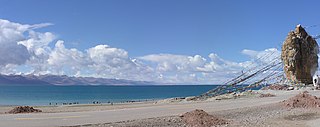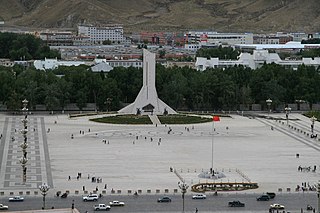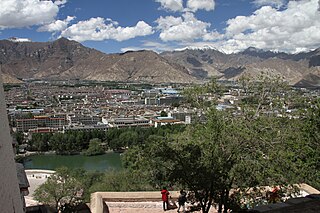
Tibet is a region in the central part of East Asia, covering much of the Tibetan Plateau and spanning about 2,500,000 km2 (970,000 sq mi). It is the homeland of the Tibetan people. Also resident on the plateau are some other ethnic groups such as the Monpa, Tamang, Qiang, Sherpa and Lhoba peoples and, since the 20th century, considerable numbers of Han Chinese and Hui settlers. Since the annexation of Tibet by the People's Republic of China in 1951, the entire plateau has been under the administration of the People's Republic of China. Tibet is divided administratively into the Tibet Autonomous Region, and parts of the Qinghai and Sichuan provinces. Tibet is also constitutionally claimed by the Republic of China as the Tibet Area since 1912.

Lhasa is the urban center of the prefecture-level Lhasa City and the administrative capital of Tibet Autonomous Region in southwest China. The inner urban area of Lhasa City is equivalent to the administrative borders of Chengguan District, which is part of the wider prefectural Lhasa City.
Shangri-La is a fictional place in Tibet's Kunlun Mountains (昆仑山), described in the 1933 novel Lost Horizon by English author James Hilton. Hilton portrays Shangri-La as a mystical, harmonious valley, gently guided from a lamasery, enclosed in the western end of the Kunlun Mountains. Shangri-La has become synonymous with any earthly paradise, particularly a mythical Himalayan utopia – an enduringly happy land, isolated from the world. In the novel, the people who live in Shangri-La are almost immortal, living hundreds of years beyond the normal lifespan and only very slowly aging in appearance.

The Roof of the World or Top of the World is a metaphoric epithet or phrase used to describe the high region in the world, also known as High Asia. The term usually refers to the mountainous interior of Asia, including the Pamirs, the Himalayas, the Tibetan Plateau, the Hindu Kush, the Tian Shan, and the Altai Mountains.

The Qinghai–Tibet railway or Qingzang railway, is a high-elevation railway that connects Xining, Qinghai Province, to Lhasa, Tibet Autonomous Region of China.
Highlands or uplands are areas of high elevation such as a mountainous region, elevated mountainous plateau or high hills. Generally, upland refers to a range of hills, typically from 300 m (980 ft) up to 500–600 m (1,600–2,000 ft), while highland is usually reserved for ranges of low mountains. However, the two terms are sometimes interchangeable.

The Tibetan independence movement is the political movement advocating for the reversal of the 1950 annexation of Tibet by the People's Republic of China, and the separation and independence of Tibet from China.
InterContinental Hotels Group (IHG), marketed as IHG Hotels & Resorts, is a British multinational hospitality company headquartered in Windsor, England. It is listed on the London Stock Exchange and the New York Stock Exchange. It is also a constituent of the FTSE 100 Index.

Shangri-La is a county-level city in Northwestern Yunnan Province, China and is the location of the seat of the Dêqên Tibetan Autonomous Prefecture, bordering Sichuan to the northwest, north, and east.

Namtso or Lake Nam is a mountain lake on the border between Damxung County of Lhasa prefecture-level city and Baingoin County of Nagqu Prefecture in the Tibet Autonomous Region of China, approximately 112 kilometres (70 mi) NNW of Lhasa.
The Lhasa Hotel, formerly known as Holiday Inn Lhasa is a 4-star hotel in the city of Lhasa, Tibet, China; lying at an altitude of 3,600 m.

The location of Tibet, deep in the Himalaya mountains, made travel to Tibet extraordinarily difficult at any time, in addition to the fact that it traditionally was forbidden to all western foreigners. The internal and external politics of Tibet, China, Bhutan, Assam, and the northern Indian kingdoms combined rendered entry into Tibet politically difficult for all Europeans. The combination of inaccessibility and political sensitivity made Tibet a mystery and a challenge for Europeans well into the 20th century.

The Lhasa River, also called Kyi Chu, is a northern tributary of the Yarlung Tsangpo River in the south of the Tibet Autonomous Region of China. The Yarlung Tsangpo is the upper section of the Brahmaputra River. The Lhasa River is subject to flooding with the summer monsoon rains, and structures have been built to control the floods. In its lower reaches the river valley is an important agricultural area. The city of Lhasa, named after the river, lies on the river. There are two large hydroelectric power stations on the river, the Zhikong Hydro Power Station (100 MW) and the Pangduo Hydro Power Station (160 MW)

The sinicization of Tibet includes the programs and laws of the Chinese government and the Chinese Communist Party (CCP) to force cultural assimilation in Tibetan areas of China, including the Tibet Autonomous Region and surrounding Tibetan-designated autonomous areas. The efforts are undertaken by China in order to remake Tibetan culture into mainstream Chinese culture.

The Ganden Sumtsenling Monastery, also known as Sungtseling and Guihuasi, is a Tibetan Buddhist monastery situated 5 kilometres (3.1 mi) from the city of Zhongdian at elevation 3,380 metres (11,090 ft) in Yunnan province, China. Built in 1679, the monastery is the largest Tibetan Buddhist monastery in Yunnan province and is sometimes referred to as the Little Potala Palace. Located in the capital of Dêqên Tibetan Autonomous Prefecture, it is also the most important monastery in southwest China.
A brief chronology of the history of Tibet:

The Londoner Macao is a casino resort on the Cotai Strip, Macau. On 5 August 2011, Sands China announced that the $4 billion property, long referred to as parcels five and six, would be officially named Sands Cotai Central. The first portion of the resort opened on 11 April 2012. The resort was rebranded as The Londoner Macao in 2021. The resort's redesign was completed in May 2023.
Prostitution in Tibet is thought to have existed for centuries. Testimonies of its existence were provided by outside visitors in the first half of the twentieth century. According to the British writer Christopher Hale, due to the practice of polyandry in Tibet, many women were unable to find a husband and moved to villages and towns, where they fell into prostitution. Their clients came from the caravans crossing the Tibetan plateau, and also from the monasteries.

Lhasa is a prefecture-level city, one of the main administrative divisions of the Tibet Autonomous Region of China. It covers an area of 29,274 square kilometres (11,303 sq mi) of rugged and sparsely populated terrain. Its urban center is Lhasa, with around 300,000 residents, which mostly corresponds with the administrative Chengguan District, while its suburbs extend into Doilungdêqên District and Dagzê District. The consolidated prefecture-level city contains additional five, mostly rural, counties.
Che Dalha, also romanized as Che Zala and Qizhala, is a Chinese politician of Tibetan ethnicity who served as Chairman (Governor) of Tibet Autonomous Region between January 2017 and October 2021. Originally from Yunnan province, he served as Communist Party Secretary of the Tibetan capital Lhasa between 2012 and 2017. Since October 2017, he is the member of the Central Committee of the Chinese Communist Party.













